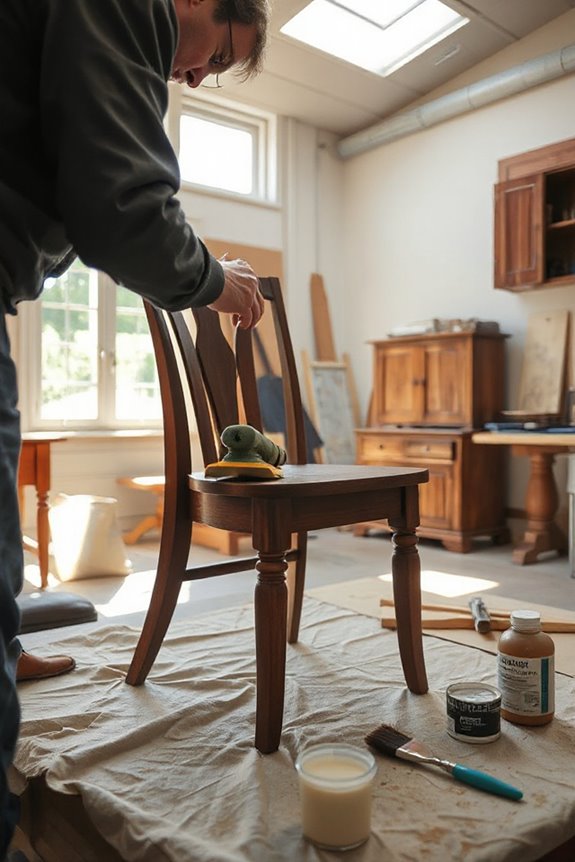Want to keep your wood furniture upright and your home safe? First, gather tools like screwdrivers, a stud finder, and wood screws. Next, locate the wall studs and attach anti-tip brackets to both the furniture and the wall. Sounds easy, right? Don’t forget to check stability after installation—just give it a gentle tug! Regularly inspect those mounts every six months to keep things safe. Hang tight; there’s more to learn about keeping your furniture secure!
Key Takeaways
- Use anti-tip brackets or straps to secure wood furniture to the wall for enhanced stability and safety.
- Ensure proper installation by anchoring into wooden studs and using suitable anchors for wall materials.
- Gather necessary tools such as a drill, stud finder, and screws for a successful restraint process.
- Regularly inspect and maintain your anchoring system every 6 to 12 months to prevent wear and tear.
- Avoid placing unstable items like snacks or toys on top of furniture, which can encourage climbing and increase tip-over risks.
Understanding the Importance of Restraining Furniture
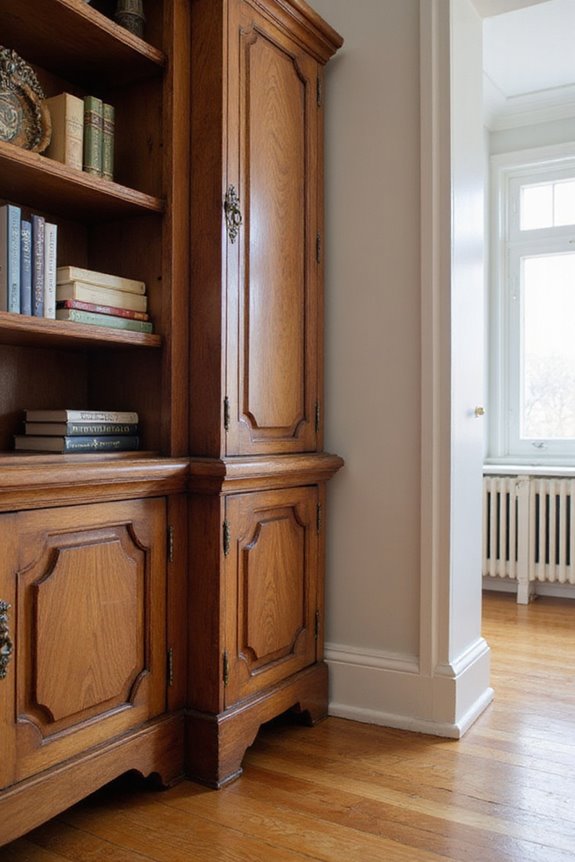
When you think about your cozy living room filled with beautiful wood furniture, you probably don’t picture it tipping over, right? But here’s a startling fact: injuries from furniture tip-overs happen every 17 minutes! This makes understanding furniture stability essential. You might think your dresser is secure, but many pieces can pose tip over risks, especially if you don’t take the time to fasten them properly. Can you imagine a heavy TV or wardrobe suddenly toppling? It’s a nightmare! Protecting your loved ones starts with simple steps—using anti-tip brackets or straps can make a world of difference. Additionally, choosing durable materials for your furniture can enhance its stability and safety. So, why not take a moment to confirm that your stunning furniture stays put and your home remains a safe haven? It’s totally worth it!
Tools and Materials Needed for Restraining
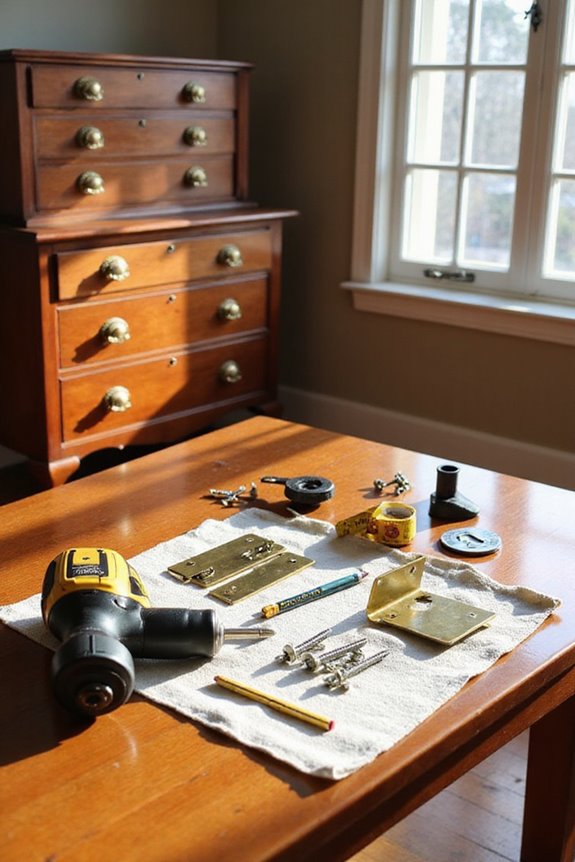
Whether you’re gearing up to secure that wobbly dresser or stabilize a towering bookshelf, having the right tools and materials on hand is essential. You’ll want to focus on tool selection, starting with screwdrivers, hammers, and chisels. Got a utility knife? It’ll help you cut through those stubborn old finishes.
Next, think about your material types. Grab some sandpaper and wood filler to smooth out imperfections. A good sander? That’s your best friend for giving that wood a polished look! You’ll also need wood screws and some fancy hardware, like knobs or hinges, to tie everything together. Investing in quality solid wood construction will enhance the durability and longevity of your furniture. So, are you ready to jump in and get that furniture looking fantastic? Let’s get to work!
Identifying Proper Anchor Points
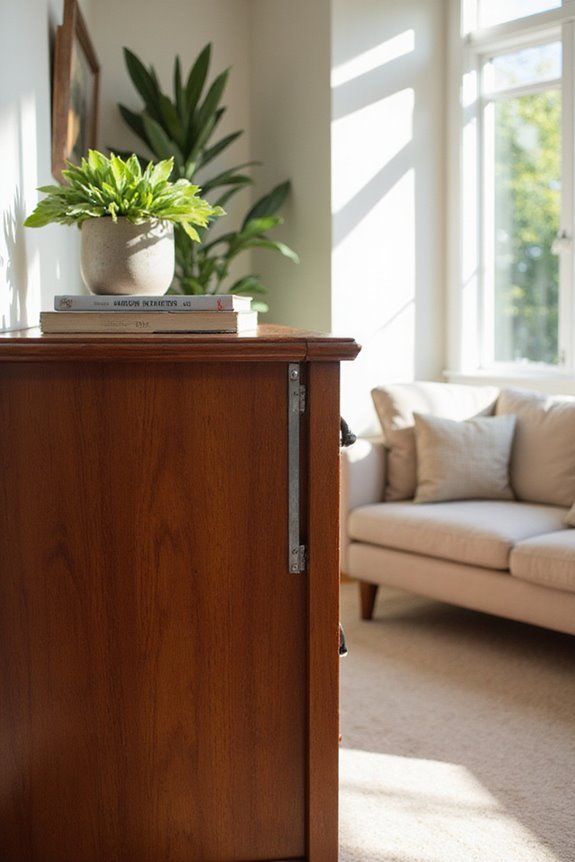
Identifying the right anchor points is essential for securing your wood furniture safely and preventing any mishaps. Have you checked if you’re anchoring into wooden studs? That’s the best bet for heavy pieces! Remember, different wall materials—like drywall—need specific anchor types. For drywall, specialized anchors can really boost stability!
Consider the weight of your furniture; it affects how many anchors you’ll need and what type you should use. Installing anchors at multiple points isn’t just a good idea; it’s vital! It helps evenly distribute weight and prevents tipping. Modern desks often require careful consideration of stability and weight distribution. Are you ready to keep your home safe? Just think of all those superhero-style furniture stands you’ll create! Let’s make sure everything stays right where it belongs!
Step-by-Step Installation Process
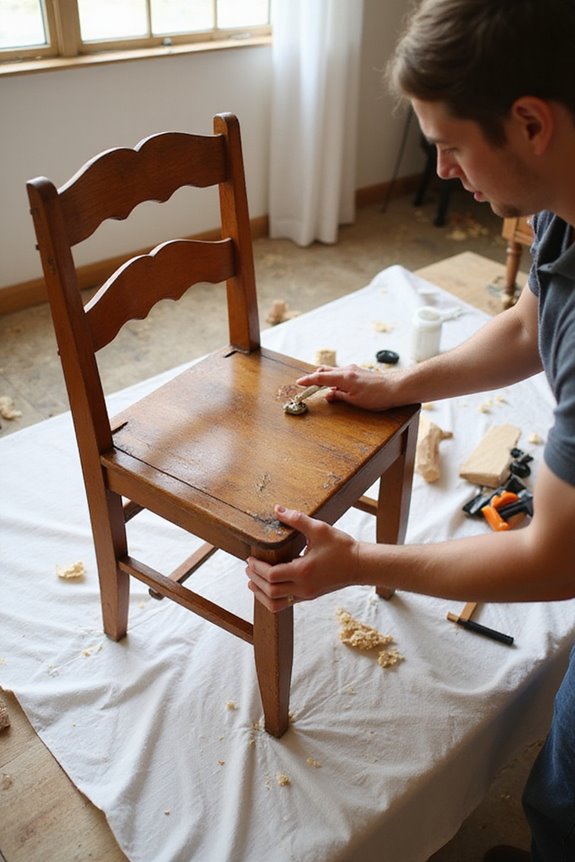
Securing your wood furniture might feel a bit intimidating, but it doesn’t have to be! First, gather your tools—like a drill, screwdriver, and stud finder—and make sure your furniture has a sturdy wood backing. Ready? Locate the studs in your wall using the stud finder; that’s essential for installation techniques!
Next, attach the mounting brackets to the back of the furniture, ensuring they align with the studs. Use proper screws here for maximum furniture stability. Don’t forget to install the heavy-duty cable strap, making sure it’s taut but not overly tight—no one wants a stressed-out piece of furniture!
Once everything’s in place, give it a gentle tug to check your hard work. Feeling confident yet?
Safety Tips and Maintenance for Anchored Furniture

When it comes to keeping your anchored furniture safe, a little regular maintenance can go a long way! Have you checked your anchoring systems lately? For ideal furniture stability, inspect those anchors every 6 to 12 months. If you notice any looseness or wear, don’t wait—replace them immediately!
Did you know that the STURDY Act now mandates safety regulations for new furniture? This means you’ve got extra peace of mind if your pieces meet those standards. However, don’t forget that older or non-compliant furniture still needs your care.
Lastly, avoid placing tempting snacks or toys on top of furniture, as this can lead to climbing. Safety first—it’s always better to be proactive than reactive!
Frequently Asked Questions
Can I Restrain Furniture Without Damaging the Wall?
Isn’t it great to keep your home safe without leaving a mark? You can absolutely secure furniture without damaging walls using adjustable straps or non-invasive anchors, ensuring both furniture safety and wall protection.
What Types of Furniture Can Be Restrained?
You can restrain various types of wood furniture, including antique pieces, dining sets, and outdoor tables. Prioritizing furniture stability guarantees longevity and aesthetic appeal, allowing you to enjoy your restored pieces for years to come.
How Long Do Restraining Straps Last?
Like a sturdy bridge, strap durability hinges on care. With proper maintenance tips—like regular inspections and cleanings—you can extend their lifespan considerably, ensuring reliability for years amidst wear and environmental challenges.
Are There Tools Required for Temporary Anchors?
Yes, there’re essential furniture safety tools for temporary anchor options. You’ll need a stud finder, a drill, and brackets to securely attach your furniture. These tools guarantee stability and safety in your home environment.
What to Do if My Furniture Is Already Tipping?
If your furniture’s tipping, prioritize safety first. Remove nearby people and pets, then focus on stabilizing it. Implement tipping prevention measures like anchoring to guarantee ongoing furniture stability and avoid future incidents.

